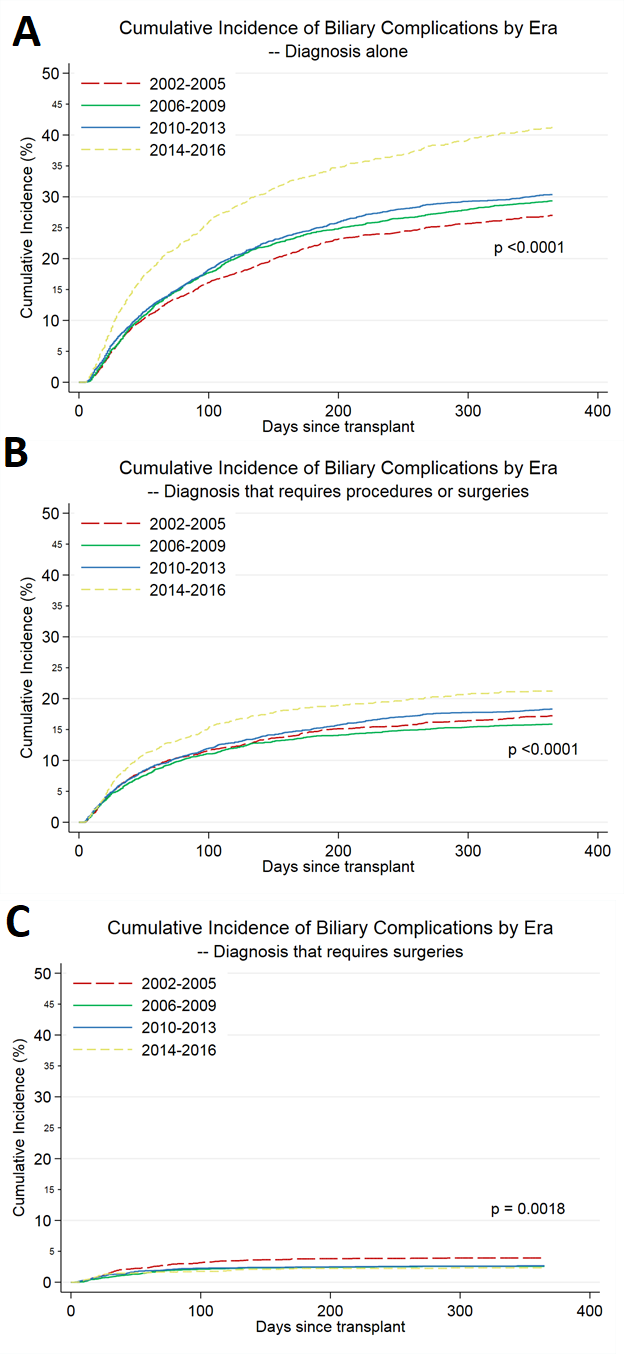Temporal Trends in the Incidence and Impact of Biliary Complications Following Liver Transplantation
1Johns Hopkins University, Baltimore, MD, 2Saint Louis University, Saint Louis, MO, 3University of Iowa, Iowa City, IA
Meeting: 2020 American Transplant Congress
Abstract number: C-147
Keywords: Bile duct, Liver transplantation
Session Information
Session Name: Poster Session C: Liver Retransplantation and Other Complications
Session Type: Poster Session
Date: Saturday, May 30, 2020
Session Time: 3:15pm-4:00pm
 Presentation Time: 3:30pm-4:00pm
Presentation Time: 3:30pm-4:00pm
Location: Virtual
*Purpose: Biliary complications (BC) are a major threat to successful liver transplantation (LT), as they are associated with a subsequent higher risk of mortality and graft loss. However, changes in recipient/donor demographics, allocation policy, and clinical protocols over the last decade might have altered the incidence and impact of post-LT BCs.
*Methods: To characterize temporal changes in the incidence and impact of post-LT BCs, we linked Medicare claims data for LT recipients to SRTR to study 13,406 Medicare-primary LT recipients from 2002-2016. BCs were ascertained by ICD-9/10 codes, and the use of endoscopic or surgical procedures for management was ascertained by CPT/HCPCS codes. Recipients were divided into three groups: (1) a biliary diagnosis alone, (2) biliary diagnosis + an endoscopic or surgical procedure, (3) biliary diagnosis + a surgical procedure. We used multi-level adjusted Cox regression to quantify temporal trends in the risk of post-LT BCs and their impact on mortality and graft loss.
*Results: The incidence of BCs increased over time, with a cumulative incidence of 27.0% in 2002-2005, 29.3% in 2006-2009, 30.4% in 2010-2013, and 41.2% in 2014-2016 (p<0.001) (Figure 1A). After accounting for donor, recipient, and transplant factors, the risk of BCs was 12% higher in 2006-2009 (adjusted hazard ratio [aHR] vs. 2002-2005: 1.021.121.23, p=0.02), 23% higher in 2010-2013 (aHR: 1.111.231.36, p<0.001), and 73% higher in 2014-2016 (aHR: 1.551.731.94, p<0.001). Although BCs were most common in LDLT recipients (50.5% vs. 29.5% in DBD recipients, p<0.001), the higher risk of BCs over time was similar across DBD, DCD, and LDLT recipients (p=0.4). BCs managed procedurally were also more common over time (aHR for 2014-2016 vs. 2002-2005: 1.131.311.53, p<0.001), whereas BCs managed surgically were less common (aHR: 0.390.580.87, p=0.007) (Figure 1B-C). In contrast to the higher risk of BCs over time, the impact of a BC on mortality and graft loss remained constant (p=0.5). Across eras, the development of a BC was associated with a 52% higher risk of mortality (aHR: 1.381.521.67, p<0.001) and 58% higher risk of graft failure (aHR: 1.441.581.74, p<0.001).
*Conclusions: The incidence of post-LT BCs has increased over time for all types of LT, and remain particularly common after DCD and LDLT. Despite a shift towards increased procedural management, the mortality and graft loss risk attributable to a BC has not decreased over time, and BCs remain a substantial driver of worse post-LT outcomes.
To cite this abstract in AMA style:
Jackson KR, Lentine K, Schnitzler M, Zhang Z, Xiao H, Motter J, Axelrod D, Segev D. Temporal Trends in the Incidence and Impact of Biliary Complications Following Liver Transplantation [abstract]. Am J Transplant. 2020; 20 (suppl 3). https://atcmeetingabstracts.com/abstract/temporal-trends-in-the-incidence-and-impact-of-biliary-complications-following-liver-transplantation/. Accessed December 24, 2025.« Back to 2020 American Transplant Congress

